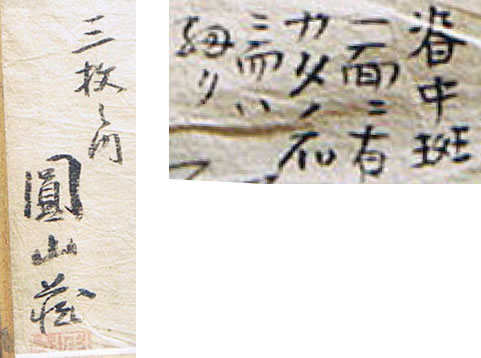A visitor to Omniglot would like your help deciphering the writing below. It comes from an old silk painting which appears Chinese, or maybe Japanese.

The bit on the left appears to be a signature which I think is 三抆向 (San Wenxiang) and perhaps the name of a town 圓山? (Yuanshan ?) – a small town in Taiwan.
The other bit of writing might be a poem, though I can’t make out all of the characters (reading vertically from right to left): 昚中斑 (shèn zhōng bān) 一面二有 (yī miàn èr yǒu). The characters in the third row from the right might be Chinese hanzi: 力夕?石 (lì xī ? shí), or Japanese katakana: カタノ石 (ka ta no shiki), and in the next line 二而? (èr ér ?). I’m not sure about the characters in the last line.
The characters in the last line look like hiragana ゐり wiri.
The third characters in the three middle lines are very small, almost like punctuation or some other symbols. Although the third character in the fourth line could also be hiragana い i.
Could the third line from the right be something line: 力夕之祀 (lì xī zhī sì) or something similar? The radical looks like it could be 示 to me. I agree with Rauli about the last like – it looks like ゐり wiri.
I appear to have swapped ‘like’ for ‘line’ somehow – maybe it’s a sign I shouldn’t be commenting on a language site!
For the photo on the right, if I try to read it like Chinese, it makes no sense to me. Considering it’s a silk painting, it doesn’t seem likely to be old enough to warrant such a “funny” combination of characters. Additionally, the handwriting in the two photos appear to belong to different people; the one on the right is clearly untrained in comparison with the one on the left. — Are these two photos showing different parts of the same painting for sure?
I’d lean toward the right photo being either in Japanese, some strange hybrid, or simply the writing of someone semi-literate. A few of the signs look like Hiragana/Katakana (but I disagree about the ゐ part; there seems to be more strokes being represented there — then again, it’s puzzling that this character/symbol is fluid/cursive while everything else in the photo is not).
As for the left photo, they seem more likely to be 三枚角 and 圓山莊 but I’m not 100% sure (especially 莊 because of that upper right dot, but if it’s a place name, 莊 would would be a very good candidate semantically speaking).
I agree with bronz’s idea that the two writings are written by different people. It is clear that the left one is written by a trained person, but the other looks like a scribble by a untrained person.
The right one is written by using a combination of Chinese characters and Japanese “katakana”, which used be a standard writing system in Japan. The first line seems to be ?中斑. In Japanese, 斑 is pronounced “madara” or “han”, and it means “spots/patches”. So this line can mean “in ?, in spots/patches”. The second line reads 一面ニ有, consisting two parts: “All over” (一面ニ) containing two Chinese characters (一面) and one “katakana” (ニ), pronounced “ichimen-ni”) and “exist” (有), which is pronounced “ari”. This line seems to be a continuation of the first line, sharing the same subject word, but I cannot find any in this writing. – Is the photo showing the whole writing?
The third line seems to be カタノ石, but the Chinese character 石 seems to be misspelled. The fourth line seems to be 二而ハ consisting of two Chinese characters 二而 and “katakana” ハ. 而二 can be read “niji”, meaning two things. In the last line, the first letter is a Chinese character and the other looks like “katakana” リ, but I don’t know this Chinese character.
As to the right photo, the first line seems to be 三枚角 or 三枚?門, and the second line is 圓山莊 or 圓山荘. I’m pretty sure that 圓山荘, which is pronounced “enzan-so” in Japanese, refers to a name of accommodation such as a country house or an inn. In fact, there are several Japanese-style accommodations named 圓山荘 in Japan!
definitely Japanese, the second line is numbers, the bottom three characters in the third line are kanji and hiragana “onna no ko” “girl” – there is a signature and probably a place name, the signature in Japanese could be “Miyakata” but there are other possibilities. Pretty calligraphy.
i’d be interested in seeing a close up of the red seal at the bottom of the left photo. that could also shed some light.